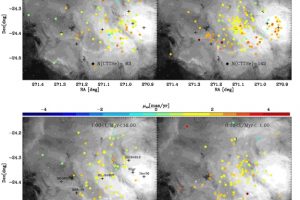The chronology of star formation in the Lagoon.The study: “The Gaia-ESO Survey: Age spread in the star forming region NGC 6530 from the HR diagram and gravity indicators” of L. Prisinzano (INAF-OAPA) recently appeared on A&A

Stars form from the gravitational contraction of large gas clouds. This process may occur in two different modes: It may be fast, with a characteristic timescale dictated by the free fall of gas onto the forming stars, or it may be slow, sustained by turbulence and magnetic field. In the former case stars form over a short period, while in the latter case the star formation process can occur over a time period of several million years.
In order to understand which is the dominant star formation mode, astronomers must observe several star forming regions, select the young stars associated to these regions, and estimate their age. This is not a trivial task. The most widely used method to estimate the age of stars is by comparing their observed photometry with that predicted by models of stellar evolution. With this method, the star formation has been dated in several star forming regions, and clues of a significant spread of stellar age suggested in some cases, such as in the Orion Nebula. These results, however, can be affected by important issues. For instance, they typically ignore some important properties or phenomena which characterize young stars, such as the gas accretion history or a spread in the distribution of stellar radii. An important help in this direction can be provided by stellar spectroscopy. By analyzing stellar spectra, in fact, it is possible to estimate stellar parameters such as temperature and surface gravity, obtaining a more reliable age estimate.
This is the approach adopted in the study: “The Gaia-ESO Survey: Age spread in the star forming region NGC 6530 from the HR diagram and gravity indicators” of L. Prisinzano (INAF – Astronomical Observatory of Palermo), to study the star formation chronology in NGC 6530 (the Lagoon Nebula). In this study, recently appeared on Astronomy & Astrophysics and part of the Gaia-ESO Survey, the authors have analyzed spectroscopic data of 2077 stars of this region obtained with FLAMES of the European Southern Observatory, together with archival photometric data and the parallaxes and proper motions provided by the Gaia satellite of the European Space Agency. Among the 652 stars associated as members of NGC 6530, it has been possible to estimate the age of 382 stars. This sample constitutes a very young population, with a median age younger than 1 million of years and a significant spread, with the oldest stars formed about 15 million years ago.The youth of the youngest stars in this sample has been confirmed by independent tests, such as the low surface gravity which is typical of the stars in their early evolutionary stage. Besides, the young stars are mainly clustered around the star 9 Sgr (a binary system with a O3.5 and a O5.5 stars) and in a filament of the cloud at south-east, where stars have a different cinematic than those in the rest of the cloud. NGC 6530 is thus one of the star forming regions characterized by a real age spread. L. Prisinzano led and international team of researchers, counting also the astronomers F. Damiani, R. Bonito, G. Micela, M. G. Guarcello, e E. Flaccomio of INAF – Astronomical Observatory of Palermo.
The figure (link to see the entire image) shows the spatial distribution of all the members of NGC 6530, split into two age bins, and separating the Classical T Tauri (stars associated with a protoplanetary disk still accreting gas) from the Weak line T Tauri (young stars which are not longer accreting from their disks).
by Mario Giuseppe Guarcello ( segui mguarce)
